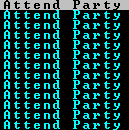- v50 information can now be added to pages in the main namespace. v0.47 information can still be found in the DF2014 namespace. See here for more details on the new versioning policy.
- Use this page to report any issues related to the migration.
Party
v50.12 · v0.47.05 This article is about the current version of DF.Note that some content may still need to be updated. |
If you have a Meeting hall designated from a table (dining room), a cage ("zoo"), a well, a statue (Sculpture garden), or a memorial (memorial hall) dwarves will throw parties there and many of your precious productive workers will now display the status Attending Party. Partying dwarves will get happy thoughts from admiring furniture and buildings, favorite caged animals, waterfalls, etc. in your meeting hall, and from making friends and talking to them. They will also slowly develop social skills. However, parties slow down your fortress's work as your dwarves relax in the meeting hall (sometimes for more than a season).
How often a dwarf will choose to attend a party is based on an internal syndrome counter named PARTIED_OUT. Dwarves should be expected to attend a party at least once every three months.
Oddly, dwarves usually cancel party attendance to get eat or drink. Dwarves will also go On Break from a party, even if that means hanging out in the same meeting hall, talking to the same people.
Parties can be canceled by "free"ing the room where they take place via q f. Turning off the room's status as a meeting hall (with q h) will not disperse a party. Recreating the room will not restart the party, although a new party may be immediately started at the meeting hall by another dwarf.
Each eligible room can have its own party going. With multiple overlapping rooms (like several tables in a dining room set to the same area), each can have its own party. If you free the room a particular party started in, the dwarves attending that party will stop partying, but those partying from other rooms (even in the same space) will keep going. If you're going to overlap rooms that can have parties, it may be best to make each room-designated construction from a different material, so you can free the correct party to get an important dwarf to go back to work.
Party Reduction & Prevention
Less-social dwarves seem to be less likely to throw parties, and less likely to make friends to invite them. Stressed dwarves also seem to be less likely to throw and attend parties. Thus antisocial and unhappy dwarves are at a lower risk to stop important labors to party.
Dwarves do not throw parties at meeting halls designated by zones. If all your meeting halls are of this type, your dwarves won't party.
Dwarves will cancel the "Attend Party" status if the meeting hall is not within their assigned burrow. This can lead to large amounts of cancellation spam.
Party Timing

|
This article or section has been rated D for Dwarf. It may include witty humour, not-so-witty humour, bad humour, in-jokes, pop culture references, and references to the Bay12 forums. Don't believe everything you read, and if you miss some of the references, don't worry. It was inevitable. |
It is a noticed trend that whenever something really important needs to be constructed lest doom fall upon the entire fortress, every dwarf capable of working will instead decide to throw a random and boring party where no one even plays 'pin-the-tail on the hoary marmot.' These parties tend to serve no purpose at all, besides wasting roughly a month of everyone's time, even if the whole fortress is starving to death. Dwarves are well known for being less than capable of prioritizing their time, but parties are above and beyond the most flagrant display of this cognitive disconnect.
